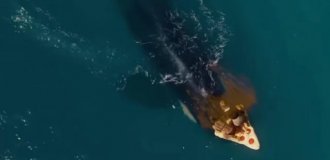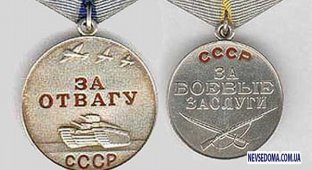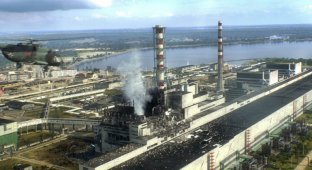Chernobyl. Memories of a pilot (4 photos)
The liquidators of the consequences of the disaster at the Fukushima-1 nuclear power plant are called kamikazes. Japan's Self-Defense Force helicopter pilots dropped giant baskets of water on emergency reactors last week to prevent fuel cell melting and radiation fires. Pilots who fly ten flights a day are considered national heroes.
25 years ago, Soviet pilots, in order to shut down the emergency reactor of the Chernobyl nuclear power plant from the air, passed through thousands of X-rays 20-30 times a day. They set out on a course in groups of three, operating practically in a combat situation of a nuclear war.
What did this “bombing” cost, the former chief of staff of the Air Force of the Kyiv Military District, Aviation Major General Nikolai Antoshkin, who led the actions of the combined aviation group and personally took to the air above the reactor several times a day, told MK. For his courage and selfless work, he was awarded the title of Hero of the Soviet Union.

“The whole shift died, we were all poisoned”
Call sign “Cup”, radiation laryngitis, delayed death. For General Antoshkin, these words are like an alarm bell.
He recalls how on the evening of April 26 he stood on the roof of the 10-story Pripyat Hotel. A light flight suit was worn over the general's uniform, and a respirator flap was placed on the face. That's all the radiation protection is. It was about a kilometer and a half away from the reactor destroyed by the explosion, emitting invisible death.
Outside the window is a nuclear forge - a reactor heated to a bright yellow color. General Antoshkin himself personally rose into the air above the reactor several times a day.
Against the background of a red glow, a huge cone of black smoke rose into the sky. For many years, a phrase uttered by one of the station workers stuck in my memory: “The whole shift died, we were all poisoned.”
Firefighters extinguished the fire around the reactor, and another 2.5 thousand tons of graphite burned inside it.

“The order from the head of the government commission Shcherbina was short: “We need your helicopters here right now,” says Nikolai Timofeevich. — There was a proposal to bring a hose with water from Pripyat, hover in a helicopter and pump water into the smoking reactor. But I convinced: “This is almost two kilometers, imagine what weight, plus windage, the helicopter will rock, it will fall, there will be a second explosion, all that will be left of you and me is steam.”
Scientists proposed tightly closing the reactor on top with a protective layer of sand. There was no way to approach the emergency block except from the air. It was necessary to start dropping sandbags from helicopters into the burning crater as quickly as possible.
The closest airfield to Chernobyl was the airfield of the Chernigov Flight School. It was urgently decided to transfer a helicopter regiment there from Alexandria. At night, in thunderstorms and low clouds, all the equipment flew over - both Mi-6 and Mi-8. The pilots were experienced, almost all had just returned from Afghanistan.
The first two Mi-8s, led by Colonels Boris Nesterov and Alexander Serebryakov, lifted members of the government commission into the air.
We measured activity above the reactor at different heights. They estimated that to dump sand it would be necessary to hover over the reactor for three to four minutes. The dose that pilots will “grab” will be from 20 to 80 roentgens. In one run! And a lot of them will need to be done.
— Approaches to the reactor from the air were dangerous; the pipe of the fourth block, the height of which was 150 meters, was in the way. To determine the approach pattern for dumping sand, the vehicles were once again lifted into the air. During takeoff and landing, the operating propellers blew away highly radioactive dust with fission fragments from the surface of the earth. The pilots were out of breath. And mothers with strollers began to roll up to the stadium where the helicopters were landing. Residents of the city showed their children the wonder of rotary-wing machines.
In Pripyat, few people realized that the total release of radioactive substances was 500 times greater than in Hiroshima. In the gardens, sprinkled with radioactive ash, the nightingales continued to sing.
At 8 a.m. in the city of nuclear scientists, all drinking establishments were open. Everyone was given free wine, vodka, beer and snacks. Doctors knew that when drinking alcohol, the human body becomes dehydrated and the likelihood of injury decreases.
At 2 p.m. buses arrived at the houses. Residents of Pripyat were told that they were leaving the city for 5-6 days. You only need to take money, documents and a minimum of personal belongings with you.
— While the evacuation was underway, aviation was prohibited from operating. They were afraid that if we started throwing sand, there would be new emissions and all this “muck” would fall on people.
The sand was found five hundred meters from the city committee, near the river station. The first bags were filled by three people: General Antoshkin and two deputy ministers of medium-sized engineering. One is in a full general’s uniform, the other two are in Moscow suits and boots.
Buses walked and walked past in an endless line. Residents of Pripyat did not yet know that they were leaving the city forever. 44,600 people were evacuated in 2.5 hours.
It is forbidden to take animals with you. For a long time, shepherd dogs, bulldogs, and lap dogs left behind by their owners ran after the buses...
“33 flights per day against the norm of 15”
As soon as the city was empty, the first Mi-8 with six bags of sand went to the target. At the helm is a first class military pilot, Colonel Boris Nesterov. The car went in a straight line towards the fourth block. Speed - 140 kilometers per hour. The helicopter hovered over the crater of a nuclear reactor. Height - 150, then dropped to 110 meters. The radiation was such that the needle of the DP-5 device, which could measure levels of up to 500 roentgens, went off scale.
At the helm is a first class military pilot, Colonel Boris Nesterov.
Above the epicenter in horizontal flight, the machine “fell” down 20-30 m. Due to the high air temperature in this place, the thrust force of the main rotor dropped sharply.
The flight engineer, tied in the cargo compartment with a cable, stuck his head out the open door and, looking into the nuclear mouth, began to dump the cargo. Sandbags flying from a height increased the release of fission fragments and radioactive ash from burnt graphite. All of this had to breathe. And then another crew went to the target... 27 vehicles worked in turn. They took off in threes. They went to the combat course one after another, in a line, like bees in a hive.
— Scientist Legasov then asked me: “How many X-rays do you tell pilots per hour at altitude?” - “1000 - 1500 roentgens.” And he: “No, you’re deceiving them. There are 3000 - 3500.”
On the first day they dropped 56 tons. Due to the unbearable heat and physical stress, the pilots and flight technicians began to vomit.
- Two or three flights - and into the bushes, a person vomits. Due to the release of a large amount of radioactive iodine-135, everyone's respirators were red. We felt the taste of metal on our lips, our tongues went numb, everyone was croaking. Every day I distributed iodine tablets to the pilots and flight technicians. The crews made 33 sorties a day, with the norm being 15-20. At the same time they said: “Yes, they shoot in Afghanistan. But you dodged, left, completed the task - and forgot. But here, in Chernobyl, you feel nothing, and you are struck by an invisible enemy. It’s worse than war.”
Few people know about the experiment conducted then. They decided to douse the crater with an aqueous liquid of a special composition, which was supposed to turn into a film and significantly reduce the transfer of radioactive dust. They said that the cost of this liquid was truly golden. Its weight was equal to the weight of the gold spent on its manufacture. They entrusted this task to the crew of the Mi-26 helicopter, which sprayed it over the object. However, the expected effect did not happen. The idea didn't work out in practice.
“We dropped 10 thousand parachutes into the reactor”
To quickly build up a protective layer, Shcherbina tried to make him fly at night. But General Antoshkin said: “Helicopter aircraft will not work over the object at night. There are no sighting devices, in the dark it is unclear where to throw the bags.”
The decision came unexpectedly. Nikolai Timofeevich remembered how, in the port of Odessa, the boom of a crane lowered huge nets loaded with bags into the holds. The general urgently sent a request to Kyiv: “Are there networks?” There were no networks. Antoshkin realized that they could be replaced with drogue parachutes. 180 pieces were immediately delivered. But the dome of the braking parachute had a cross-shaped shape, so technicians had to manually sew the edges of these crosses.
— The group initially consisted of almost 80 vehicles. Every morning, helicopters flew from operational airfields to three sites located near the nuclear power plant. Each of them had its own flight director and a foreman with a radio station, who commanded groups of fighters - reserve soldiers called up for training from various military districts. The mobilized civilians were called “partisans.”
One day they told me on the radio that they had rebelled. When I arrive, bearded civilians with bellies stand in front of me. They say in unison: “There is a high level of radiation here, we don’t have any protective equipment, we won’t load bags.” I say: “Who is in front of you? General And he’s been in the zone since day one. And he also loaded bags. The pilots are standing, waiting for loading. You don’t pass over the reactor, where there are thousands of X-rays, but they pass through. Our first helipads were 500-800 meters from the reactor. As soon as the background radiation on the ground increased, we changed sites and moved further and further away. When you see a general running, run too. Until he runs, you must work here.” And the soldiers began to load the bags into the parachutes.

Chernobyl. April 1986
But it suddenly became clear that the active build-up of the sand layer caused an unexpected increase in temperature at the emergency reactor. The scientists became worried and decided to throw only lead. Lead came from all over the Union: in the form of blanks, bars, and bags of shot. Pilots began placing thin plates under the seats and covering the floors of helicopters with them. This protection was thought of when hundreds of tons of cargo had already been dropped onto the reactor.
At the end of the working day, the equipment went for decontamination, the crews went to the bathhouse. Everyone who visited the zone had their uniform and boots changed.
— When the dose of external radiation was more than 37 roentgens, I removed the pilots from flights and assigned them to supervise flights at the Cup-1 site. This was the case with Colonel Boris Nesterov, who was on the front line from the first day. I categorically forbade him to appear above the reactor. But after a short time I heard his voice on the air again. I never raise my voice to my subordinates, but then I had a blast. Nesterov received the full program.
“Minus 11 kilos, plus 608 roentgens”
Antoshkin had a chance to take a nap for 4 hours only after four days, when the work was already established. The crews reached the target in a continuous stream. Helicopters took off and landed every 30 seconds. The general removed the excess amount of aircraft from the group. Instead of 80 cars, there are about 30 left.
By order of Antoshkin, the first 27 crews were sent to Kyiv and Moscow for examination and treatment.
The pilots arrived at the hospital hoarse, with a characteristic radiation tan on their faces. Doctors discovered that their thyroid gland, lymph nodes and liver were severely infected with radionuclides. Over the course of a month, uranium and plutonium salts were washed out of the heroes’ blood, replacing the blood many times.
To stay in aviation, they tore out pages from their medical books where the true doses of radiation received were recorded - 100 roentgens each, but entered only 31. Many did not know that their death was simply delayed.
“In 10 days in the zone, I also picked up a fair amount of radiation,” says Nikolai Timofeevich. — I had a dosimeter in my pocket all the time. I received a dose of approximately 605-608 roentgens and lost 11 kilograms. When I arrived home, I slept for a day and a half, my wife just pushed me, poured some tea into my mouth, and I immediately fell asleep again.
In the Kiev hospital, doctors shied away from the general. The HIR (human radiation counter) began to buzz as he approached. Antoshkin was given Aerovit, but the pilots always have these vitamins on their table, and also sleeping pills. Nothing else. Nikolai Timofeevich took off his pajamas, put on a general's uniform with stripes and climbed over the fence. He escaped and never appeared in the hospital again.

“To classify the death of the crew”
While Antoshkin led the actions of the combined aviation group in Chernobyl, it did not lose a single person either on the ground or in the air.
The tragedy happened in the fall of 1986. There was a rally going on. We summed up the results: one of the walls of the sarcophagus was built. Helicopters flew up to the object and sprayed it with a decontamination solution. The crew of the Mi-8 helicopter, flying under the boom of a 160-meter German crane, caught its tail on a cable and fell to the ground.
Not a single report about the death of the helicopter appeared in the Soviet press. Only recently have the names of the pilots become known.
The crew commander is a 1st class pilot, 30-year-old captain Vladimir Vorobyov, who miraculously escaped death twice. In the accident, his motorcycle collided with a truck. The motorcycle is soft-boiled, Vladimir has only bruises and scratches. Then he was the only one to survive in Afghanistan in a downed helicopter. “Fluttered” from 70 meters and survived. And he died in Chernobyl. The day before the disaster, Vladimir sent all his belongings to his family in Yaroslavl. I also included a gold ring bought as a gift for my wife in the parcel.
Flight mechanic Leonid Khristich had 365 Afghan combat missions under his belt. Fate also took care of him. One day, the fuel tank in their helicopter was punctured, and until landing, Senior Lieutenant Khristich covered the holes with his hands. It was completely saturated with fuel; all it took was a spark and it would turn into a burning torch. But it went through and landed safely.
Navigator Senior Lieutenant Alexander Yungkind did not go to Afghanistan due to health reasons. It turned out to be suitable for Chernobyl.
The fourth person on board the crashed Mi-8 was 26-year-old aircraft mechanic Nikolai Ganzhuk. He loved the sky, dreamed of flying since childhood, entered an aviation school, but did not pass the medical examination. When nuclear engineers asked him and his crew to go up to the reactor for measurements, he climbed into the hatch with pleasure.
When the memorial to the victims of the Chernobyl nuclear power plant was opened, the dead firefighters and operators were remembered at the rally. Not a word was said about the fact that the helicopter pilots who eliminated the consequences of the disaster died there.
At the field airfield in Maleyki, where aircraft were decontaminated, a graveyard of helicopters and engines remained. The memory of the lost Mi-8 was also buried in radioactive debris.























